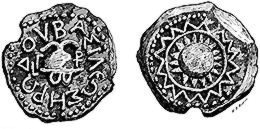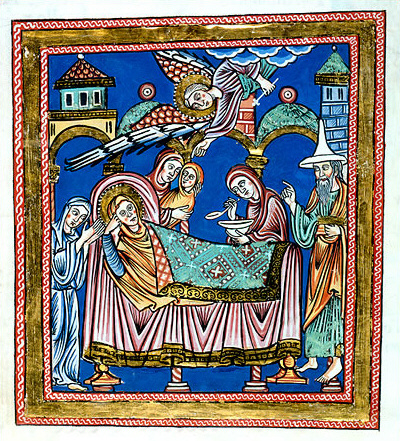|
Wadi Al-Qelt
Wadi Qelt ( ar, وادي القلط; Qelt is also spelled Qilt and Kelt, sometimes with the Arabic article, el- or al-), in Hebrew Nahal Prat ( he, נחל פרת), formerly Naḥal Faran (Pharan brook), is a valley, riverine gulch or stream ( ar, وادي ', "wadi"; he, נחל, "nahal") in the West Bank, originating near Jerusalem and running into the Jordan River near Jericho, shortly before it flows into the Dead Sea. The wadi attracts with a number of natural, biblical, and archaeological highlights: a well preserved natural environment with a rich wild bird population. Geography The stream flowing eastwards down the valley that cuts through the limestone of the Judean Mountains, has three perennial springs, each with an Arabic and Hebrew name: 'Ayn Farah/En Prat, the largest one at the head of the valley; 'Ayn Fawar/En Mabo'a in the centre; and the single-named Qelt spring a little farther down. In Hebrew the entire stream is called Prat; in Arabic thoug ... [...More Info...] [...Related Items...] OR: [Wikipedia] [Google] [Baidu] |
Lesser Kestrel
The lesser kestrel (''Falco naumanni'') is a small falcon. This species breeds from the Mediterranean across Afghanistan and Central Asia, to China and Mongolia. It is a summer bird migration, migrant, wintering in Africa and Pakistan and sometimes even to India and Iraq. It is rare north of its breeding range, and declining in its European range. The genus name derives from Late Latin ''falx'', ''falcis'', a sickle, referencing the claws of the bird, and the species name commemorates the German naturalist Johann Friedrich Naumann. Description It is a small bird of prey, in length with a wingspan. It looks very much like the larger common kestrel but has proportionally shorter wings and tail. It shares a brown back and barred grey underparts with the larger species. The male has a grey head and tail like male common kestrels, but lacks the dark spotting on the back, the black Cheek, malar stripe, and has grey patches in the wings. The female and young birds are slightly paler ... [...More Info...] [...Related Items...] OR: [Wikipedia] [Google] [Baidu] |
Ehud Netzer
Ehud Netzer ( he, אהוד נצר 13 May 1934 – 28 October 2010) was an Israeli architect, archaeologist and educator, known for his extensive excavations at Herodium, where in 2007 he found the tomb of Herod the Great; and the discovery of a structure defined by Netzer as a synagogue, which if true would be the oldest one ever found (the "Wadi Qelt Synagogue"). Netzer served as a professor at the Institute of Archaeology at the Hebrew University in Jerusalem. He was a world-renowned expert on Herodian architecture. Netzer worked at Masada with Yigael Yadin, and later completed the official excavation report for the site. He later led teams of archaeologists who did important fieldwork at the Herodian palace at Jericho. At Herodium, in the desert near Bethlehem and south of Jerusalem, for more than three decades, Netzer oversaw extensive excavations focusing on remains at the foot and on the sides of the artificial mountain. Biography Ehud Netzer was born in Jerusalem in 1934 ... [...More Info...] [...Related Items...] OR: [Wikipedia] [Google] [Baidu] |
Herod The Great
Herod I (; ; grc-gre, ; c. 72 – 4 or 1 BCE), also known as Herod the Great, was a Roman Jewish client king of Judea, referred to as the Herodian kingdom. He is known for his colossal building projects throughout Judea, including his renovation of the Second Temple in Jerusalem and the expansion of the Temple Mount towards its north, the enclosure around the Cave of the Patriarchs in Hebron, the construction of the port at Caesarea Maritima, the fortress at Masada, and Herodium. Vital details of his life are recorded in the works of the 1st century CE Roman–Jewish historian Josephus. Herod also appears in the Christian Gospel of Matthew as the ruler of Judea who orders the Massacre of the Innocents at the time of the birth of Jesus, although most Herod biographers do not believe that this event occurred. Despite his successes, including singlehandedly forging a new aristocracy from practically nothing, he has still been criticised by various historians. His reign pola ... [...More Info...] [...Related Items...] OR: [Wikipedia] [Google] [Baidu] |
Hasmonean Royal Winter Palaces
The Hasmonean royal winter palaces are a complex of Hasmonean and Herodian buildings from the Second Temple period, which were discovered in the western plain of Jericho valley, at Tulul Abu al-'Alayiq, near the place where the Roman road connecting Jericho with Jerusalem enters Wadi Qelt. Two tells are located on either side of Wadi Qelt. The palaces are evidence of the luxurious lifestyle of the Hasmonean dynasty and of Herod the Great. They made extensive use of swimming pools, bathhouses, ornamental gardens and orchards. The palaces were not far from Jerusalem – 20 km along the ancient Roman road. History of excavations The site was excavated in the 19th century by Charles Warren, who attempted to locate the place of Biblical Jericho. After making an archaeological trench, he concluded that this site is from the Roman period. Additional excavations were conducted by the Germans Ernst Sellin and Carl Watzinger, in 1910–1911, but the results have never been publis ... [...More Info...] [...Related Items...] OR: [Wikipedia] [Google] [Baidu] |
Hasmonean Dynasty
The Hasmonean dynasty (; he, ''Ḥašmōnaʾīm'') was a ruling dynasty of Judea and surrounding regions during classical antiquity, from BCE to 37 BCE. Between and BCE the dynasty ruled Judea semi-autonomously in the Seleucid Empire, and from roughly 110 BCE, with the empire disintegrating, Judea gained further autonomy and expanded into the neighboring regions of Perea, Samaria, Idumea, Galilee, and Iturea. Some modern scholars regard the Hasmonean realm as an independent Israel. The Hasmonean rulers took the Greek title '' basileus'' ("king" or "emperor"). Forces of the Roman Republic conquered the Hasmonean kingdom in 63 BCE and made it into a client state; Herod the Great displaced the last reigning Hasmonean client-ruler in 37 BCE. Simon Thassi established the dynasty in 141 BCE, two decades after his brother Judas Maccabeus ( ''Yehudah HaMakabi'') had defeated the Seleucid army during the Maccabean Revolt of 167 to 141 BCE. According to 1 Maccabees, 2 Maccabee ... [...More Info...] [...Related Items...] OR: [Wikipedia] [Google] [Baidu] |
Qubur Bani Isra'in
Qubur Bene Isra'in or Qubur Bani Isra'il (''lit.'' "Tombs of the Children of Israel"), are four, formerly five, huge stone structures dated to the Middle Bronze Age, which rise from a rocky plateau overlooking Wadi Qelt in the West Bank, about 3.5 miles northeast of Jerusalem, between Hizma and Geva Binyamin along Highway 437. History Clermont-Ganneau, followed by Macalister, identified the site with the tomb of the biblical matriarch Rachel based on the biblical text (). It can be hypothesised from the name ''Qaber Um Bene Israin'', "Tombs of the Mothers of the Sons of Israel", that this is the tomb of Rachel (see ), or that there is a connection to the death and burial of the nurse Deborah "below Bethel" from , as well as to the passage about the oak of Tabor being near Rachel's tomb in 1 Samuel 10. The Israel Antiquities Authority survey gives the site the identification code Hizma, site number 480 in Benjamin, coordinates 17580 and 13880. Archaeological evidence shows that the ... [...More Info...] [...Related Items...] OR: [Wikipedia] [Google] [Baidu] |
St Anne
According to Christian apocryphal and Islamic tradition, Saint Anne was the mother of Mary and the maternal grandmother of Jesus. Mary's mother is not named in the canonical gospels. In writing, Anne's name and that of her husband Joachim come only from New Testament apocrypha, of which the Gospel of James (written perhaps around 150) seems to be the earliest that mentions them. The mother of Mary is mentioned but not named in the Quran. Christian tradition The story is similar to that of Samuel, whose mother Hannah ( he, ''Ḥannāh'' "favour, grace"; etymologically the same name as Anne) had also been childless. The Immaculate Conception was eventually made dogma by the Catholic Church following an increased devotion to Anne in the 12th century. Dedications to Anne in Eastern Christianity occur as early as the 6th century. In the Eastern Orthodox tradition, Anne and Joachim are ascribed the title ''Ancestors of God'', and both the Nativity of Mary and the Presentation of ... [...More Info...] [...Related Items...] OR: [Wikipedia] [Google] [Baidu] |
Proto-Gospel Of James
The Gospel of James (or the Protoevangelium of James) is a second-century infancy gospel telling of the miraculous conception of the Virgin Mary, her upbringing and marriage to Joseph, the journey of the couple to Bethlehem, the birth of Jesus, and events immediately following. It is the earliest surviving assertion of the perpetual virginity of Mary, meaning her virginity not just prior to the birth of Jesus, but during and afterwards, and despite being condemned by Pope Innocent I in 405 and rejected by the Gelasian Decree around 500, became a widely influential source for Mariology. Composition Date, authorship, and sources The Gospel of James was well known to Origen in the early third century and probably to Clement of Alexandria at the end of the second, so is assumed to have been in circulation soon after ''circa'' 150 AD. The author claims to be James the half-brother of Jesus by an earlier marriage of Joseph, but in fact his identity is unknown. Early studies assumed a ... [...More Info...] [...Related Items...] OR: [Wikipedia] [Google] [Baidu] |
Apocryphal
Apocrypha are works, usually written, of unknown authorship or of doubtful origin. The word ''apocryphal'' (ἀπόκρυφος) was first applied to writings which were kept secret because they were the vehicles of esoteric knowledge considered too profound or too sacred to be disclosed to anyone other than the initiated. ''Apocrypha'' was later applied to writings that were hidden not because of their divinity but because of their questionable value to the church. In general use, the word ''apocrypha'' has come to mean "false, spurious, bad, or heretical". Biblical apocrypha are a set of texts included in the Septuagint and the Latin Vulgate, but not in the Hebrew Bible. While Catholic Church, Catholic tradition considers some of these texts to be deuterocanonical books, deuterocanonical, and the Orthodox Churches consider them all to be canonical, Protestants consider them apocryphal, that is, non-canonical books that are useful for instruction. Luther's Bible placed them in a ... [...More Info...] [...Related Items...] OR: [Wikipedia] [Google] [Baidu] |
Virgin Mary
Mary; arc, ܡܪܝܡ, translit=Mariam; ar, مريم, translit=Maryam; grc, Μαρία, translit=María; la, Maria; cop, Ⲙⲁⲣⲓⲁ, translit=Maria was a first-century Jewish woman of Nazareth, the wife of Joseph and the mother of Jesus. She is a central figure of Christianity, venerated under various titles such as virgin or queen, many of them mentioned in the Litany of Loreto. The Eastern and Oriental Orthodox, Church of the East, Catholic, Anglican, and Lutheran churches believe that Mary, as mother of Jesus, is the Mother of God. Other Protestant views on Mary vary, with some holding her to have considerably lesser status. The New Testament of the Bible provides the earliest documented references to Mary by name, mainly in the canonical Gospels. She is described as a young virgin who was chosen by God to conceive Jesus through the Holy Spirit. After giving birth to Jesus in Bethlehem, she raised him in the city of Nazareth in Galilee, and was in Jerusal ... [...More Info...] [...Related Items...] OR: [Wikipedia] [Google] [Baidu] |
Joachim
Joachim (; ''Yəhōyāqīm'', "he whom Yahweh has set up"; ; ) was, according to Christian tradition, the husband of Saint Anne and the father of Mary, the mother of Jesus. The story of Joachim and Anne first appears in the Biblical apocryphal Gospel of James. His feast day is 26 July, a date shared with Saint Anne. In Christian tradition The story of Joachim, his wife Anne (or Anna), and the miraculous birth of their child Mary, the mother of Jesus, was told for the first time in the 2nd-century apocryphal infancy-gospel the Gospel of James (also called Protoevangelium of James). Joachim was a rich and pious man, who regularly gave to the poor. However, Charles Souvay, writing in the ''Catholic Encyclopedia'', says that the idea that Joachim possessed large herds and flocks is doubtful. At the temple, Joachim's sacrifice was rejected, as the couple's childlessness was interpreted as a sign of divine displeasure. Joachim consequently withdrew to the desert, where he fasted and ... [...More Info...] [...Related Items...] OR: [Wikipedia] [Google] [Baidu] |







